After reading a small section of the introduction to my class textbook Classical Archaeology by Susan Alcock and Robin Osbourne, I was able to realize certain aspects of the book and to obtain a clearer definition of what classical archaeology is.
Classical archaeology as defined by the textbook is the study of the items that define our past. This does not simply imply the past of our wonderful blue marble Earth, but rather the human past; why we think the way we do, why we perceive the arts and the mind the way we do and in some cases, even earlier examples of modern tools we have. Though humans have technically existed for over 2 million years, we can say that the origins of our western ways of thinking began with the Classical Era of Greece and Rome. As a result, classical archaeology is not simply the study of items that are seen as classical but rather it is the study and the discovery of items that define an important part of human history: The Classical Period.
The textbook itself is organized in a very non-traditional way. As opposed to many textbooks that are organized in a fashion that begins with one civilization and is then sub-divided into the different categories of artifacts that exist from that civilization, Classical Archaeology speaks of both civilizations at one time (so as to compare them) under the same category of artifacts.
Some themes that will be discussed in Classical Archaeology include questions such as: What patterns of human behaviour can be established by the study of tools, artifacts, assemblages and sites? How can civic centres reflect the social lives of Greeks and Romans? What does a spread of artistic motif or style of stone used on buildings say about the interactions between communities of the Classical period? (Alcock and Osbourne, 2-3).
I believe the textbook will be a great tool to be used in understanding the aspects of classical archaeology as well as being able to make our theories and statements based on the textbook.
Saturday, January 25, 2014
Thursday, January 23, 2014
Pottery Shapes
There are multiple styles of pottery used in Ancient Greece, many of which were subdivided for specific tasks. Here are examples of the different styles of pottery that existed in Ancient Greece:
Amphorae
Belly Amphorae
Panathenaic Prize Amphorae
Neck Amphorae
Pelike
Kraters
Column-Krater
Volute-Krater
Calyx Krater
Bell-Krater
Psykter
Other Carrying Vessels
Lebes or Dinos
Loutrophoros
Hyrdia
Stamnos
Pouring Vessels
Oinochoe, olpe and chows
Kyathos
Cups
Komast
Siana
Little Master
Type A
Type B
Type C
Stemless
Other Drinking Vessels
Skyphos, Mastos and Mastoid
Kantharos
Rhyton
Oil
Amphorae
Wine and Water
Kraters
Water
Hydria
Loutrophoros
Wine
Oinochoe
Psykter
Brygos and Exekias were Greek pottery painters during the classical era. Though they were separated by 100 years, they are each very influential in the decoration of pottery and cups during the 6th and 5th century BCE. However they differ in many ways as well.
Brygos was a painter in the late 5th century who worked in red-figure vase painting
through the late Archaic period. He is said to be one of the most iconic of his time alongside his contemporaries Onesimos and Makron. Brygos' work is often characterized by the flat-topped, long noses and narrow arched eyes of his characters in the symposiums and palaistras he created. The expression in his characters' faces were often quite effective in carrying the message he wished to portray in his paintings. His ability to paint the human mouth was exceptional, often showing his characters whistling or singing with great anatomical accuracy. Through this, one could assume that he was quite observant of human behaviour, emotion and expression.
Exekias on the other hand was an earlier painter of the mid 6th century who working in black-figure vase painting. This method was executed using through the use of clay that turned black when heated and creating details by making small incisions. Contemporaries of his, such as Andokides and Lysippides were most likely also his students. His themes were usually based on mythological recreations or even original stories. Exekias was also quite exceptional with details, often being able to put much detail into the hair of his characters. He is often said to have much more than just a visual aspect to his paintings but also a psychological aspect that add deeper meaning to his images. Most interesting of Exekias and his style of painting is the "wheel and spoke" style of painting he creates through the use of line. His ability to let the viewer focus on a central aspect of the image without them wandering to far from this central aspect is something that only later existed in 17th century Renaissance painting. His ability to do this so far before is possibly why he is so renowned as a classical artist.
Amphorae
Belly Amphorae
Panathenaic Prize Amphorae
Neck Amphorae
Pelike
Kraters
Column-Krater
Volute-Krater
Calyx Krater
Bell-Krater
Psykter
Other Carrying Vessels
Lebes or Dinos
Loutrophoros
Hyrdia
Stamnos
Pouring Vessels
Oinochoe, olpe and chows
Kyathos
Cups
Komast
Siana
Little Master
Type A
Type B
Type C
Stemless
Other Drinking Vessels
Skyphos, Mastos and Mastoid
Kantharos
Rhyton
Amphorae
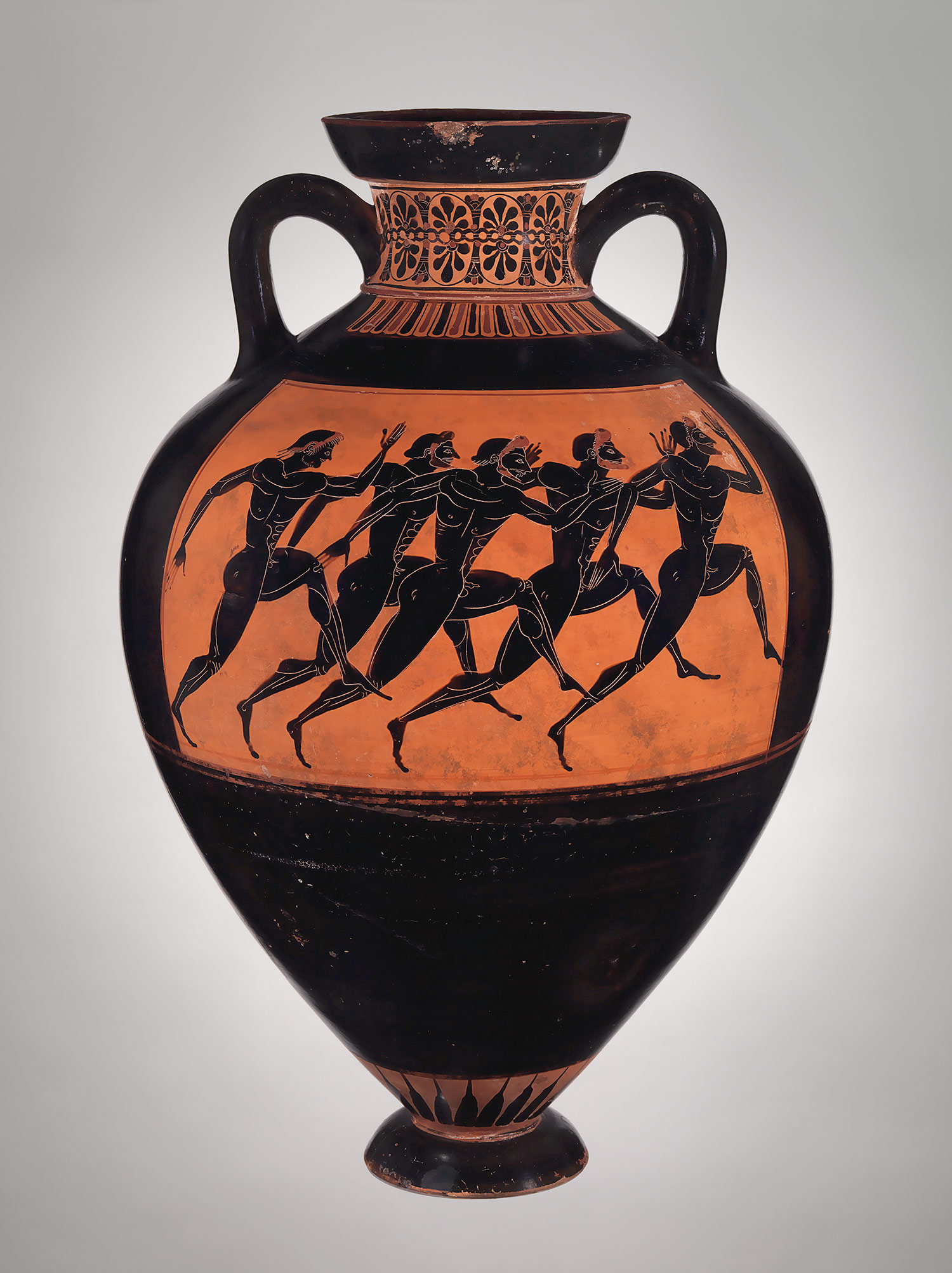 |
| This would be an example of a Panathenaic Amphorae |
Wine and Water
Kraters
| Column-Krater used for mixing water and wine |
Water
Hydria
 |
| Common Hydria used more storing and pouring water |
Loutrophoros
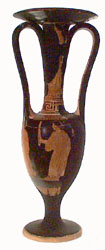 |
| A loutrophoros: used to store water and sometimes used in marriage and funerary rituals |
Wine
Oinochoe
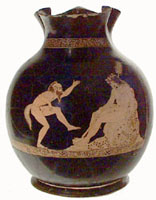 |
| A wine container to that was usually where it was served from |
Psykter
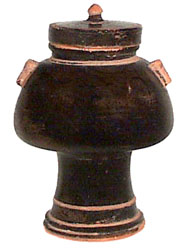 |
| Used for cooling wine |
Brygos and Exekias were Greek pottery painters during the classical era. Though they were separated by 100 years, they are each very influential in the decoration of pottery and cups during the 6th and 5th century BCE. However they differ in many ways as well.
Brygos was a painter in the late 5th century who worked in red-figure vase painting
through the late Archaic period. He is said to be one of the most iconic of his time alongside his contemporaries Onesimos and Makron. Brygos' work is often characterized by the flat-topped, long noses and narrow arched eyes of his characters in the symposiums and palaistras he created. The expression in his characters' faces were often quite effective in carrying the message he wished to portray in his paintings. His ability to paint the human mouth was exceptional, often showing his characters whistling or singing with great anatomical accuracy. Through this, one could assume that he was quite observant of human behaviour, emotion and expression.
Exekias on the other hand was an earlier painter of the mid 6th century who working in black-figure vase painting. This method was executed using through the use of clay that turned black when heated and creating details by making small incisions. Contemporaries of his, such as Andokides and Lysippides were most likely also his students. His themes were usually based on mythological recreations or even original stories. Exekias was also quite exceptional with details, often being able to put much detail into the hair of his characters. He is often said to have much more than just a visual aspect to his paintings but also a psychological aspect that add deeper meaning to his images. Most interesting of Exekias and his style of painting is the "wheel and spoke" style of painting he creates through the use of line. His ability to let the viewer focus on a central aspect of the image without them wandering to far from this central aspect is something that only later existed in 17th century Renaissance painting. His ability to do this so far before is possibly why he is so renowned as a classical artist.
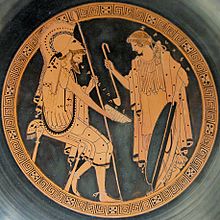 |
| An example of Brygos' work |
 |
| An example of Exekias' work |
Subscribe to:
Comments (Atom)